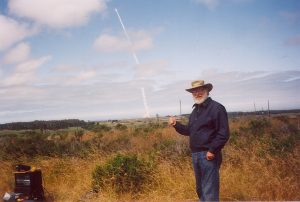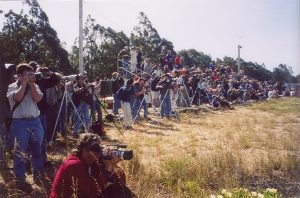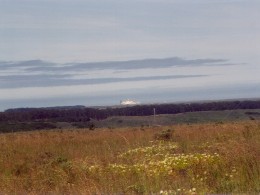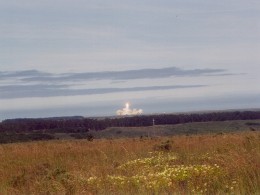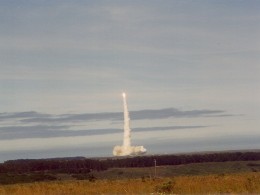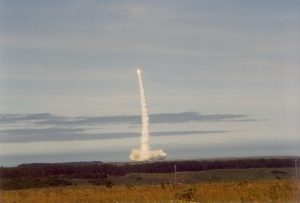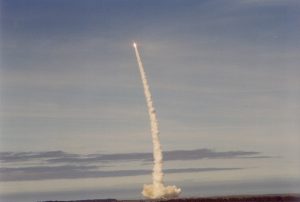7 AM, 4/19/04. We stumble out of bed. I eat a banana, Lee turns on the coffee machine, we check our email and turn on CNN. More dead people in Iraq. We shower. Then, instead of making breakfast, we pile into the car and pick up our usual road breakfast at Mickey Dee’s and head down California Route 1 to Vandenberg AFB. It’s 35 miles from our front door, but I’m not sure how long the trip will take. Traffic is sometimes slow, 2-lane roads most of the way.
The map I downloaded says we should turn on Firefighter Road to get to the Vandenberg weather station. We meander on that a while, the base housing just getting visible behind big stands of eucalyptus trees, turn on another road, and within a short time come on a lot of cars parked on both sides of the road. The website warned us we had a quarter-mile walk to the viewing area.
It’s a perfect day. Not a breath of wind, not a cloud in the sky. We pass three yellow school buses and soon reach a car barrier. A fair number of people are walking with us. A lot more than I expected, frankly. Through a parking lot and over some sand with sparse grasses and iceplant growing in it and we come to the small concrete grandstand, about six rows of seats. They are full, and there are many other people standing. Almost everyone has a videocam, binoculars, or a still camera. Some of them are on tripods, with lenses as long as your arm. One guy has a big orange Questar telescope with camera attachment.
About five miles away is the blue Pacific, and I can see a railroad bridge that we crossed about a month ago on our trip to Texas, when we saw the Vandenberg launch facilities from a much closer vantage point than you would ever get on a launch day. No trains will be going by for the next few hours, because they are launching today, a Delta II rocket carrying the NASA Gravity Probe-B.
* * *
I did a little reading about the GPB. It’s a pretty amazing gizmo.
“Ptolemy invented a universe and it lasted 2000 years. Newton invented a universe and it lasted 200 years. Now Doctor Einstein has invented a new universe and no one knows how long this one is going to last.” ~George Bernard Shaw
At the time Shaw wrote that Einstein’s universe had probably been around for about 20 years. It’s lasted a lot longer than that, but there have been some problems with it right from the very first. Ptolemy’s universe described what was happening in the sky with great accuracy, but he had no idea what was really going on. Newton’s picture was lots better, and Einstein didn’t really upset it so much as fill in the very fine details, mostly of things that happened either on a very large or a very small scale. Some people thought it wouldn’t make much difference in our lives, but those were people who didn’t really understand what E=mc squared implied. It changed a lot of lives on August 6, 1945.
The trouble is, when you get down to the really fine stuff, relativity clashes with quantum theory in many ways. General relativity has accurately predicted so many things that I had thought it was pretty well accepted as written. Not so. In fact, it is probably the least tested theory in general acceptance. Much of it is accepted simply because we haven’t been able to come up with an experiment that would either validate or disprove a particular part of it.
The GPB is designed to test something called “frame dragging.” This is the idea that a large spinning mass will actually drag the fabric of space-time with it as it turns. Now, this would be an easy idea to test in the near neighborhood of a black hole … easy, that is, if you could survive being close to a black hole, which seems unlikely. The sun is tough, too. Get close enough to measure the effect and you’re toast. Literally.
But the Earth would produce such an effect, too. Just very, very, very tiny. A gyroscope in orbit around the Earth should, without frame dragging, stay with its axis pointed in the same direction forever. With frame dragging, it should precess about 40 milliarc-seconds in a year. A milliarc-second is an angle the width of a human hair seen from 10 miles away. How are you going to measure a thing like that?
* * *
9:20 AM, 4/19/04. We’re early (though we’re some of the last to arrive). Speakers are set up on tripods, broadcasting the incomprehensible chatter of the launch crew and the updates from the official mission control announcer. We learn that everything is going very well, all green, except the upper atmosphere winds. The countdown has two built-in holds during the last hour, wiggle room, I guess, in case a problem comes up that hasn’t been anticipated. But there will be no interminable holds today, as I recall from my early days watching Mercury launches on the black-and-white TV, and that still happen quite often in the space program. The launch window for the GPB is one second. It will leave by 10:01:01, or it won’t go until tomorrow. Every time we hear that all systems are go a cheer goes up.
We enter the last hold at 14 minutes to launch time, T minus 4 minutes and holding, high altitude winds still not within the mission parameters. There is one last weather balloon on its way up, due to be there just before the count resumes. Everybody is edgy. In the distance we hear helicopters, but can seldom spot them. (Hard to sneak up on somebody with a helicopter.) A Coast Guard cutter is keeping station out in the sea, warning off people who might wander too close. A beautiful red-tail hawk soars over us and lands briefly on a telephone pole by a steel instrument tower. Then he takes off and soars on thermals until I can’t see him anymore.
The speakers tell us they will resume the count in thirty seconds, then ten seconds, then we hear, “T minus four minutes and counting.” There’s a cheer. A short pause, and then mission control tells us that the Boeing flight manager had scrubbed the flight. Later we learn that upper altitude winds are just marginally within acceptable parameters, but the manager felt it was cutting things a bit too close. We’re all disappointed, of course, but if I were him, deciding whether to light the fuse on a $700,000,000 project that has taken well over 40 years to come to fruition … well, there isn’t enough anti-anxiety medication in the world to allow me to be in that position, but I’m with him. Better safe than sorry. Launch time tomorrow will be 9:57 AM, PDT.
On the way home we visit the alternate viewing site on our map, the golf course parking lot. It is a wee bit closer … and it’s deserted. Nobody’s even playing golf. No wonder; there’s a low rise between us and the pad. You wouldn’t see the lift-off. Screw that. Tomorrow we’ll be back at the weather station.
* * *
“Einstein’s general relativity theory, though profoundly beautiful, is likely to be amended.” ~Nobel Laureate C.N. Yang
That’s the thing. Nobody thinks Einstein’s theory will be toppled, any more than Einstein invalidated Newton. Newton’s laws work perfectly well for almost everything we do, except certain electronic applications. But relativity and quantum theory are profoundly anti-intuitive. The universe is a very weird place, on the atomic level, on the astronomical level. Some things just don’t make much sense to me, no matter how hard I study them. They can only really be understood by mathematics, and I don’t have the math. But I find them fascinating, as mind games if nothing else. Einstein himself used “thought experiments” to demonstrate how relativity worked.
The heart of the GPB is four gyroscopes. They are made of fused quartz, the size of Ping-Pong balls, and they are by far the most perfectly spherical objects ever made. They are in fact so spherical that there is nothing on Earth, or even in the solar system, remotely as perfectly round as these objects. This degree of roundness simply does not occur in nature. So far as we know (barring alien civilizations with better technology) you’d have to go to the nearest neutron star to find something more perfectly round. I find that mind-boggling.
If planet Earth was machined to the tolerances of these gyroscopes, the new crystal planet’s Mount Everest would be eight feet above sea level. The Marianas Trench in the Pacific Ocean would be eight feet deep. Not the greatest planet for bungee jumping or mountain climbing or scuba diving. You could wade across the oceans. It would be a good planet for ice skating, though, and you wouldn’t even need skates. The problem would be standing up at all. If you managed to stand, you wouldn’t be able to move unless you hoisted a sail or used a rocket engine. Awkward.
These little balls are coated with niobium, enclosed in sockets of fused quartz, and will be set spinning at 10,000 rpm by jets of helium moving at supersonic speed. Once revved up, they can be expected to lose about 1% of their rotation in 1000 years.
The whole business is set into a number of concentric lead cans and cooled to less than 2 degrees Kelvin by superfluid liquid helium. They have to be isolated from everything but the effects of relativistic frame dragging, and that is an almost impossible task. But they seem confident that they have done it. The problems they solved would make a hell of an interesting book, but I’m afraid I wouldn’t understand a lot of it. Example: You’ve got a perfectly round, perfectly featureless sphere turning at 10,000 rpm in a vacuum much emptier than the surrounding space at 400 miles altitude. How do you tell if it’s slowing down? How do you tell if the axis is staying pointed in the same direction. Just looking at it, you wouldn’t be able to tell it’s spinning at all!
You can’t make a mark of any kind on it. That would unbalance it. In fact, almost anything you could do to observe it, to measure it, would affect the rotation in one way or another. They found a way. If you expect me to tell you about it, you’re in for a disappointment, because I didn’t really grasp the explanation. It has to do with something called the London moment, and has to do with a magnetic field generated in a superfluid. This is measured by an instrument called a SQUID (Superconducting QUantum Interference Device). I have to take their word for it. But they seem confident they can isolate these gyros to the degree needed, and measure the changes that result. I hope so. I will eagerly await the results. Was Einstein right? Stay tuned.
* * *
7:30 AM, 4/20/04. We stumble out of bed. I eat a banana, Lee turns on the coffee machine, we check our email and turn on CNN. More dead people in Iraq. We shower. Then, instead of making bacon and eggs, we pile into the car and pick up our usual road breakfast at Mickey Dee’s and head down California Route 1 to Vandenberg AFB … I realize that, aside from getting up 30 minutes later, we’re repeating yesterday. We could get good at this. I hope we don’t have to. If it doesn’t go today, it won’t go until Thursday because they’ll have to purge the liquid helium tanks and refill them.
It’s the usual suspects at the weather station, too, except the school buses from Santa Barbara aren’t there. We arrive with only about 20 minutes of the countdown left. We learn that this time everything looks good. There are some high, thin clouds; otherwise, it’s a repeat of yesterday. The launch complex and the Delta II rocket look tiny from this distance. Even my binoculars don’t show me much.
I’ve never seen a big rocket launch. No chance to see a Saturn V now, but when they start launching shuttles again I really want to get down to Florida and see one. The Delta II isn’t as big as that, but it’s big enough. I really don’t know what to expect. Lee is taking pictures; right up to T minus ten seconds she snaps a picture of the crowd watching.
At T minus 2 the main engine ignites, and at zero six of the nine strap-on solid fuel boosters light off. The whole place is swallowed up in smoke for a few seconds, then the bird lifts out of it, moving slowly. The brightness of the flame shocks me, it actually hurts my eyes, it’s like an arc welder, almost as bright as the sun.
One thing you cannot appreciate on TV is the speed with which it accelerates. It’s poking along … and suddenly it is moving like a bat out of hell. All of this in silence, except for the crowd cheering and clapping. It would be impossible to watch this sitting down. Couldn’t be done, unless you were paralyzed. I feel myself choking up, I’ve waited 56 years for this, and I believe I must have a very stupid grin on my face. Then the sound arrives, when the bird is already way, way up there. It rolls over us like thunder, getting louder and louder. I wouldn’t want to be a lot closer than we are without some major ear protection.
I hoped we’d see the separation of the six boosters, but it was already too far away for that. We saw it later, on the NASA Channel, at home.
“Forty miles in altitude, one hundred miles downrange.” Awesome! It’s only been a couple of minutes. Mission control announces all these figures I’ve heard so many times before, watching shuttle launches, but it’s different being there, still watching it, realizing how fast it is accelerating, how far fast it is moving, how far away it is.
The vapor trail begins to twist in the high-altitude winds. The sound fades away. We watch it until it’s a thin line of white, then gone. A few people leave, but many more linger around the speakers, listening for MECO, SECO, and establishment of the orbit. News will come slowly now, and in a year … we should really know something.
Next launch is June 9th, a Minuteman. I’ll probably be there.
April 21, 2004
Oceano, California

